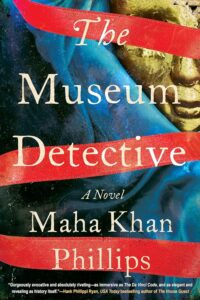 Dr. Gul Delani is an art historian working at the Museum of History and Heritage in Karachi, Pakistan. She has basically forced her way into the museum by more or less creating her own department and curating her own staff of eager grad students. When she gets a middle of the night phone call, she thinks it’s information about her long missing niece, Mahnaz, who had vanished at 15, but instead, it’s an order to get dressed and get in a car for a long ride. When she arrives, she’s asked to take a look at what could possibly be the mummy of a legendary princess of Persepolis.
Dr. Gul Delani is an art historian working at the Museum of History and Heritage in Karachi, Pakistan. She has basically forced her way into the museum by more or less creating her own department and curating her own staff of eager grad students. When she gets a middle of the night phone call, she thinks it’s information about her long missing niece, Mahnaz, who had vanished at 15, but instead, it’s an order to get dressed and get in a car for a long ride. When she arrives, she’s asked to take a look at what could possibly be the mummy of a legendary princess of Persepolis.
Since Mummification was not a known method of corpse disposal in ancient Iran, this discovery could be paradigm changing, and Gul is beside herself with excitement when the police agree to deliver the mummy to her museum for further investigation. Her grad students share her excitement and do their best to create a secure environment for remains that could be thousands of years old. For assistance, Gul calls on an old Cambridge friend, Harry, who facilitates the translation of the cuneiform on the mummy’s tomb.
To me the actual main character of this novel is Karachi itself, and the author, who was born there, paints a vivid picture of daily life in the capital, as well as Gul’s specific routine, which includes volunteering at a shelter where she teaches classes. Coming from a wealthy family she has an array of connections, both high and low, and it’s the street connections who help her when the mummy disappears.
Meanwhile a miasma of grief surrounds Gul. Her niece has been missing for three years, but the powerful sense of loss remains, with the continuing uncertainty making things even worse. Mahnaz is always in the back of Gul’s mind, but to her immense frustration her parents and upwardly mobile brother and straight-laced sister-in-law really don’t want to talk about the situation anymore. Gul pushes forward to discover what has happened to the mummy, with several attempts made on her life as she begins to unravel the crime and the true origins of the mysterious artifact. Since this is a mystery, astute readers know the stories of the missing mummy and the missing niece must inevitably intersect.
I loved Gul the character, and was gripped by the story of her close relationship with her niece, who seems to share more traits with her aunt than with her uptight parents. As Gul reads through Mahnaz’s diaries, the girl comes alive to the reader, making her loss all the more poignant. I won’t give away the resolutions that Phillips provides, so you may have the pleasure of reading the book for yourself to discover them. When I closed the covers I felt I had been on both an armchair and emotional journey to the city of Karachi. — Robin Agnew